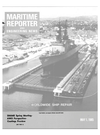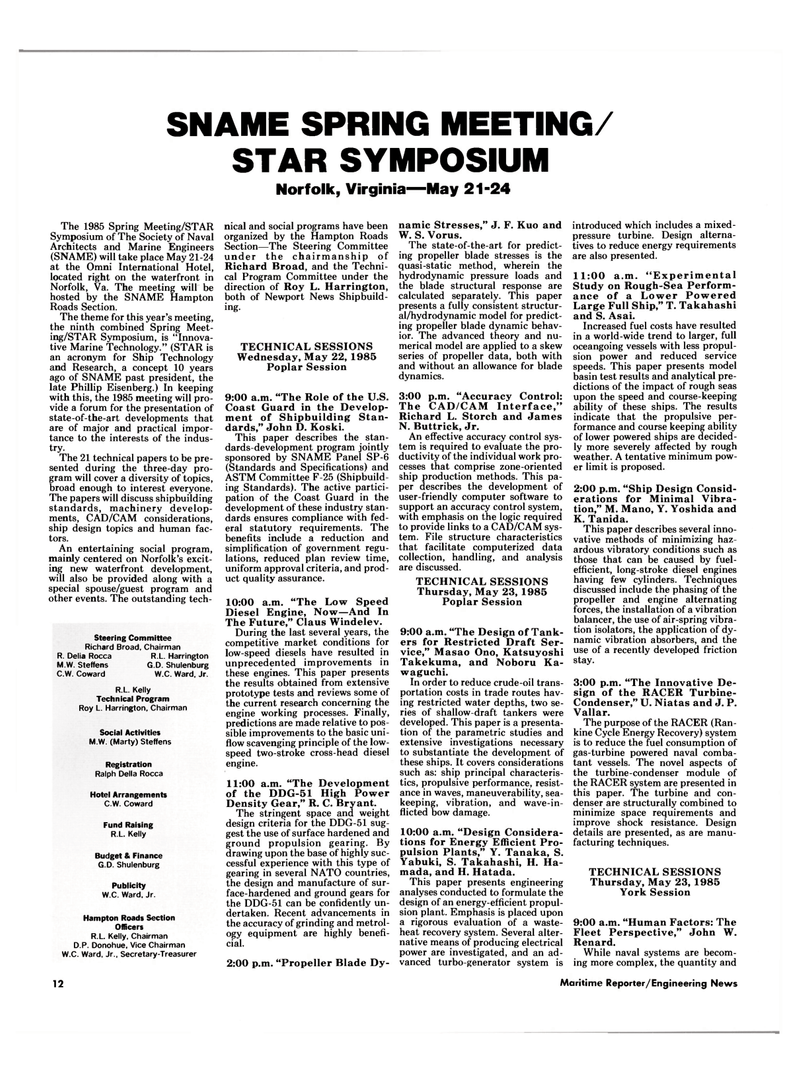
Page 3rd Cover: of Maritime Reporter Magazine (May 1985)
Read this page in Pdf, Flash or Html5 edition of May 1985 Maritime Reporter Magazine
SNAME SPRING MEETING/
STAR SYMPOSIUM
Norfolk, Virginia—May 21-24
The 1985 Spring Meeting/STAR
Symposium of The Society of Naval
Architects and Marine Engineers (SNAME) will take place May 21-24 at the Omni International Hotel, located right on the waterfront in
Norfolk, Va. The meeting will be hosted by the SNAME Hampton
Roads Section.
The theme for this year's meeting, the ninth combined Spring Meet- ing/STAR Symposium, is "Innova- tive Marine Technology." (STAR is an acronym for Ship Technology and Research, a concept 10 years ago of SNAME past president, the late Phillip Eisenberg.) In keeping with this, the 1985 meeting will pro- vide a forum for the presentation of state-of-the-art developments that are of major and practical impor- tance to the interests of the indus- try.
The 21 technical papers to be pre- sented during the three-day pro- gram will cover a diversity of topics, broad enough to interest everyone.
The papers will discuss shipbuilding standards, machinery develop- ments, CAD/CAM considerations, ship design topics and human fac- tors.
An entertaining social program, mainly centered on Norfolk's excit- ing new waterfront development, will also be provided along with a special spouse/guest program and other events. The outstanding tech-
Steering Committee
Richard Broad, Chairman
R. Delia Rocca R.L. Harrington
M.W. Steffens G.D. Shulenburg
C.W. Coward W.C. Ward. Jr.
R.L. Kelly
Technical Program
Roy L. Harrington. Chairman
Social Activities
M.W. (Marty) Steffens
Registration
Ralph Delia Rocca
Hotel Arrangements
C.W. Coward
Fund Raising
R.L. Kelly
Budget & Finance
G.D. Shulenburg
Publicity
W.C. Ward, Jr.
Hampton Roads Section
Officers
R.L. Kelly, Chairman
D.P. Donohue, Vice Chairman
W.C. Ward, Jr., Secretary-Treasurer nical and social programs have been organized by the Hampton Roads
Section—The Steering Committee under the chairmanship of
Richard Broad, and the Techni- cal Program Committee under the direction of Roy L. Harrington, both of Newport News Shipbuild- ing.
TECHNICAL SESSIONS
Wednesday, May 22, 1985
Poplar Session 9:00 a.m. "The Role of the U.S.
Coast Guard in the Develop- ment of Shipbuilding Stan- dards," John D. Koski.
This paper describes the stan- dards-development program jointly sponsored by SNAME Panel SP-6 (Standards and Specifications) and
ASTM Committee F-25 (Shipbuild- ing Standards). The active partici- pation of the Coast Guard in the development of these industry stan- dards ensures compliance with fed- eral statutory requirements. The benefits include a reduction and simplification of government regu- lations, reduced plan review time, uniform approval criteria, and prod- uct quality assurance. 10:00 a.m. "The Low Speed
Diesel Engine, Now—And In
The Future," Claus Windelev.
During the last several years, the competitive market conditions for low-speed diesels have resulted in unprecedented improvements in these engines. This paper presents the results obtained from extensive prototype tests and reviews some of the current research concerning the engine working processes. Finally, predictions are made relative to pos- sible improvements to the basic uni- flow scavenging principle of the low- speed two-stroke cross-head diesel engine. 11:00 a.m. "The Development of the DDG-51 High Power
Density Gear," R. C. Bryant.
The stringent space and weight design criteria for the DDG-51 sug- gest the use of surface hardened and ground propulsion gearing. By drawing upon the base of highly suc- cessful experience with this type of gearing in several NATO countries, the design and manufacture of sur- face-hardened and ground gears for the DDG-51 can be confidently un- dertaken. Recent advancements in the accuracy of grinding and metrol- ogy equipment are highly benefi- cial. 2:00 p.m. "Propeller Blade Dy- namic Stresses," J. F. Kuo and
W. S. Vorus.
The state-of-the-art for predict- ing propeller blade stresses is the quasi-static method, wherein the hydrodynamic pressure loads and the blade structural response are calculated separately. This paper presents a fully consistent structur- al/hydrodynamic model for predict- ing propeller blade dynamic behav- ior. The advanced theory and nu- merical model are applied to a skew series of propeller data, both with and without an allowance for blade dynamics. 3:00 p.m. "Accuracy Control:
The CAD/CAM Interface,"
Richard L. Storch and James
N. Buttrick, Jr.
An effective accuracy control sys- tem is required to evaluate the pro- ductivity of the individual work pro- cesses that comprise zone-oriented ship production methods. This pa- per describes the development of user-friendly computer software to support an accuracy control system, with emphasis on the logic required to provide links to a CAD/CAM sys- tem. File structure characteristics that facilitate computerized data collection, handling, and analysis are discussed.
TECHNICAL SESSIONS
Thursday, May 23, 1985
Poplar Session 9:00 a.m. "The Design of Tank- ers for Restricted Draft Ser- vice," Masao Ono, Katsuyoshi
Takekuma, and Noboru Ka- waguchi.
In order to reduce crude-oil trans- portation costs in trade routes hav- ing restricted water depths, two se- ries of shallow-draft tankers were developed. This paper is a presenta- tion of the parametric studies and extensive investigations necessary to substantiate the development of these ships. It covers considerations such as: ship principal characteris- tics, propulsive performance, resist- ance in waves, maneuverability, sea- keeping, vibration, and wave-in- flicted bow damage. 10:00 a.m. "Design Considera- tions for Energy Efficient Pro- pulsion Plants," Y. Tanaka, S.
Yabuki, S. Takahashi, H. Ha- mada, and H. Hatada.
This paper presents engineering analyses conducted to formulate the design of an energy-efficient propul- sion plant. Emphasis is placed upon a rigorous evaluation of a waste- heat recovery system. Several alter- native means of producing electrical power are investigated, and an ad- vanced turbo-generator system is introduced which includes a mixed- pressure turbine. Design alterna- tives to reduce energy requirements are also presented. 11:00 a.m. "Experimental
Study on Rough-Sea Perform- ance of a Lower Powered
Large Full Ship," T. Takahashi and S. Asai.
Increased fuel costs have resulted in a world-wide trend to larger, full oceangoing vessels with less propul- sion power and reduced service speeds. This paper presents model basin test results and analytical pre- dictions of the impact of rough seas upon the speed and course-keeping ability of these ships. The results indicate that the propulsive per- formance and course keeping ability of lower powered ships are decided- ly more severely affected by rough weather. A tentative minimum pow- er limit is proposed. 2:00 p.m. "Ship Design Consid- erations for Minimal Vibra- tion," M. Mano, Y. Yoshida and
K. Tanida.
This paper describes several inno- vative methods of minimizing haz- ardous vibratory conditions such as those that can be caused by fuel- efficient, long-stroke diesel engines having few cylinders. Techniques discussed include the phasing of the propeller and engine alternating forces, the installation of a vibration balancer, the use of air-spring vibra- tion isolators, the application of dy- namic vibration absorbers, and the use of a recently developed friction stay. 3:00 p.m. "The Innovative De- sign of the RACER Turbine-
Condenser," U. Niatas and J. P.
Vallar.
The purpose of the RACER (Ran- kine Cycle Energy Recovery) system is to reduce the fuel consumption of gas-turbine powered naval comba- tant vessels. The novel aspects of the turbine-condenser module of the RACER system are presented in this paper. The turbine and con- denser are structurally combined to minimize space requirements and improve shock resistance. Design details are presented, as are manu- facturing techniques.
TECHNICAL SESSIONS
Thursday, May 23, 1985
York Session 9:00 a.m. "Human Factors: The
Fleet Perspective," John W.
Renard.
While naval systems are becom- ing more complex, the quantity and 12 Maritime Reporter/Engineering News

 9
9

 4th Cover
4th Cover
